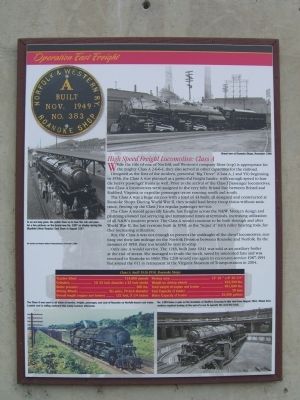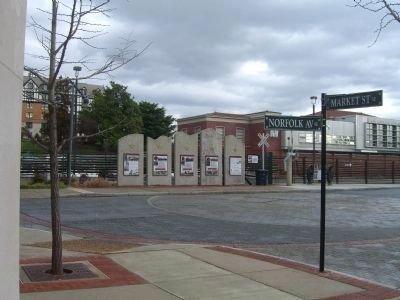Downtown in Roanoke, Virginia — The American South (Mid-Atlantic)
Operation Fast Freight
The David R. and Susan S. Goode Railwalk
High Speed Freight Locomotive: Class A
While the title of one of Norfolk and Western’s company films (top) is appropriate for the mighty Class A 2-6-6-4, they also served in other capacities for the railroad. Designed as the first of the modern, powerful “Big Three” (Class A, J and Y6) beginning in 1936, the Class A was planned as a powerful freight hauler, with enough speed to handle heavy passenger trains as well. Prior to the arrival of the Class J passenger locomotives, two Class A locomotives were assigned to the very hilly Bristol line between Bristol and Radford, Virginia to expedite passenger trains running north and south.
The Class A was huge success with a total of 43 built; all designed and constructed at Roanoke Shops. During World War II, they would haul heavy troop trains without assistance, freeing up the Class J for regular passenger service.
The Class A would generally handle fast freight across the N&W. Modern design and planning allowed fast servicing and turnaround times at terminals, increasing utilization of all N&W’s modern power. The Class A would continue to be built through and after World War II, the last versions built in 1950, as the “Super A” with roller bearing rods, further increasing utilization.
But, the Class A was not enough to prevent the onslaught of the diesel locomotives, running out their last mileage on the Norfolk Division between Roanoke and Norfolk. By the summer of 1959, they too would be sent to scrap.
Only one A would survive. The 1218, built June 1943 was sold as an auxiliary boiler at the end of steam. She managed to evade the torch, saved by interested fans and was returned to Roanoke in 1969. The 1218 would run again in excursion service 1987-1991 but joined the 611 in retirement at the Virginia Museum of Transportation in 2004.
[Table in lower center of marker]
Cylinders: (4) 24 inch diameter x 32 inch stroke
Boiler pressure: 300 lbs.
Driving Wheels: Six pairs, 70 inch diameter
Overall length (engine and tender): 121 foot, 9 ¼ inches
Firebox area: 13’ 10” x 8’ 10 ¼”
Weight on driving wheels: 432,350 lbs.
Total weight of engine and tender: 951,600 lbs.
Coal Capacity of tender: 30 tons
Water Capacity of tender: 20,000 gallons
Erected 2007.
Topics. This historical marker is listed in this topic list: Railroads & Streetcars. A significant historical year for this entry is 1936.
Location. Marker has been reported permanently removed. It was located near 37° 16.387′ N, 79° 56.339′ W. Marker was in Roanoke, Virginia. It was in Downtown. Marker was at the intersection of Norfolk Avenue SE and Market Street SE, on the right when traveling west on Norfolk Avenue SE. Touch for map. Marker was in this post office area: Roanoke VA 24011, United States of America.
We have been informed that this sign or monument is no longer there and will not be replaced. This page is an archival view of what was.
Other nearby markers. At least 8 other markers are within walking distance of this location. Roanoke Shops (a few steps from this marker); Today's Rail Traffic (within shouting distance of this marker); Norfolk and Western Passenger Station (within shouting distance of this marker); The Market Square Walkway (within shouting distance of this marker); Hotel Roanoke (within shouting distance of this marker); a different marker also named Hotel Roanoke (about 400 feet away, measured in a direct line); North Jefferson Street (about 500 feet away); Welcome to Historic Roanoke City Market (about 500 feet away). Touch for a list and map of all markers in Roanoke.
More about this marker. All pictures are Norfolk and Western Railway photos provided for the marker from the collection of Kenneth L. Miller. Their captions follow:
[top photo]: Brand new at Roanoke Shops, November 1948
[top left photo]: In an era long gone, the public lines up to tour the cab and pose for a few pictures on the brand-new No. 1207 on display during the Bluefield (West Virginia) Coal Show in August 1937.
[lower left photo]: The Class A was used in all kinds of service, freight, passenger, and east of Roanoke on Norfolk-bound coal trains. Loaded coal is rolling eastward this sunny summer afternoon.
[lower right photo]: No. 1203 takes a spin on the turntable at Shaffers Crossing in this view from August 1941. Steam locomotives required turning at the end of a run to operate the next trip back.
Credits. This page was last revised on February 1, 2023. It was originally submitted on January 15, 2009, by Kevin W. of Stafford, Virginia. This page has been viewed 981 times since then and 8 times this year. Last updated on February 14, 2021, by Shane Oliver of Richmond, Virginia. Photos: 1, 2. submitted on January 15, 2009, by Kevin W. of Stafford, Virginia. • Bill Pfingsten was the editor who published this page.

